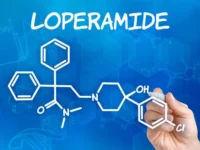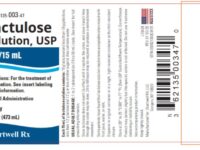Lactulose is a synthetic sugar compound that is commonly used as a laxative. It is primarily indicated for the treatment of constipation and hepatic encephalopathy, a condition that affects individuals with severe liver disease. The mechanism of action by which lactulose exerts its therapeutic effects involves several processes within the body.
Lactulose is a non-absorbable disaccharide made up of two sugar molecules, lactose and fructose, which are not metabolized by the body. When lactulose reaches the colon, it is fermented by colonic bacteria, leading to the production of short-chain fatty acids, predominantly lactic acid and acetic acid. This acidification of the colonic contents results in several important physiological effects.
Firstly, lactulose acts as an osmotic laxative. Its presence in the colon increases the osmotic pressure, drawing water into the bowel lumen. This leads to softening and increased volume of the stools, facilitating their passage and relieving constipation. Lactulose also stimulates peristalsis, the muscular contractions that move the stool through the intestines, further aiding in the relief of constipation.
Another important mechanism of action of lactulose is its ability to decrease the pH of the colonic contents. The acidity created by the fermentation of lactulose inhibits the growth of ammonia-producing bacteria within the colon. Ammonia is a toxic compound that is normally produced as a byproduct of bacterial metabolism in the gut. In individuals with liver disease, impaired liver function leads to the accumulation of ammonia in the blood, which can then cross the blood-brain barrier and cause neurological abnormalities, known as hepatic encephalopathy. By reducing the ammonia levels in the colon, lactulose helps prevent its absorption into the bloodstream, thereby alleviating hepatic encephalopathy symptoms.
Furthermore, lactulose promotes the growth of beneficial bacteria in the colon, such as Lactobacillus and Bifidobacterium species. These bacteria help maintain a healthy gut microbiota and contribute to normal gastrointestinal function. By restoring the balance of gut flora, lactulose can improve overall digestive health.
In summary, lactulose acts as an osmotic laxative by increasing osmotic pressure and stimulating peristalsis. It also acidifies the colonic contents, inhibiting the growth of ammonia-producing bacteria and reducing ammonia levels in the colon. Additionally, lactulose promotes the growth of beneficial bacteria, contributing to a healthy gut microbiota. These combined effects make lactulose an effective treatment for constipation and hepatic encephalopathy.
Lactulose, a synthetic disaccharide, is widely known for its effectiveness in treating constipation and hepatic encephalopathy. Its mechanism of action primarily involves its unique properties in the gastrointestinal tract, where it exerts both osmotic and prebiotic effects.
Upon oral administration, lactulose undergoes minimal digestion in the small intestine due to the absence of suitable enzymes, thus reaching the colon largely unchanged. Once in the colon, lactulose is fermented by the gut microbiota, leading to the production of short-chain fatty acids (SCFAs), primarily acetate, propionate, and butyrate.
The fermentation of lactulose by colonic bacteria results in the acidification of the colonic contents, which increases the osmotic pressure within the bowel lumen. This osmotic effect draws water into the colon, softening the stool and promoting bowel movements. Consequently, lactulose serves as an osmotic laxative, aiding in the relief of constipation.
Furthermore, the production of SCFAs through lactulose fermentation contributes to the acidification of the colonic environment, which helps inhibit the growth of ammonia-producing bacteria. This property is particularly relevant in the management of hepatic encephalopathy, a condition characterized by elevated blood ammonia levels and neurological symptoms in patients with liver dysfunction.
Moreover, lactulose acts as a prebiotic by selectively stimulating the growth and activity of beneficial bacteria, such as Bifidobacteria and Lactobacilli, in the colon. These beneficial bacteria play a crucial role in maintaining gut health and promoting overall well-being.
In summary, the multifaceted mechanism of action of lactulose involves its fermentation by colonic bacteria, resulting in the production of SCFAs, increased osmotic pressure in the colon, inhibition of ammonia-producing bacteria, and promotion of the growth of beneficial gut flora. These mechanisms collectively contribute to the therapeutic effects of lactulose in managing constipation and hepatic encephalopathy.
“The Science Behind Lactulose: Understanding its Mechanism” delves into the intricate pathways through which lactulose exerts its therapeutic effects. This title highlights the scientific investigation and comprehension required to elucidate how lactulose operates within the body.
In exploring this topic, one would delve into the biochemical and physiological processes that underpin lactulose’s mechanism of action. This includes its journey through the gastrointestinal tract, its interaction with gut microbiota, and the resulting physiological responses.
Understanding the science behind lactulose involves grasping concepts such as osmotic pressure, colonic fermentation, and the production of short-chain fatty acids (SCFAs). These components are pivotal in comprehending how lactulose softens stool, promotes bowel movements, and modulates the gut environment.
Moreover, the title suggests a focus on the interdisciplinary nature of lactulose’s mechanism, which integrates knowledge from pharmacology, microbiology, and gastroenterology. By unpacking the intricate science behind lactulose, researchers and healthcare professionals can better appreciate its clinical applications and therapeutic potential in conditions such as constipation and hepatic encephalopathy.
Deciphering Lactulose: How it Works in the Body
“Deciphering Lactulose: How it Works in the Body” implies a quest to unravel the complexities of lactulose’s functionality within the human physiology. This title suggests an investigative journey aimed at understanding the intricate mechanisms through which lactulose exerts its therapeutic effects.
To decipher lactulose’s action in the body, one must explore its passage through the gastrointestinal tract, its interactions with the microbiota residing in the colon, and the resultant physiological responses. This involves delving into its unique properties as a synthetic disaccharide and its resistance to digestion in the small intestine.
Lactulose’s mode of action involves multiple facets, including its osmotic effect, which draws water into the colon, softening the stool and facilitating bowel movements. Furthermore, lactulose serves as a substrate for fermentation by colonic bacteria, leading to the production of short-chain fatty acids (SCFAs) and acidification of the colonic environment.
Understanding how lactulose works in the body requires consideration of its therapeutic applications, such as its role in managing constipation and hepatic encephalopathy. It also involves exploring its prebiotic effects, which promote the growth of beneficial gut bacteria and contribute to overall gastrointestinal health.
Read also: Uses Of Paracetamol and Mefenamic Acid Suspension
“Deciphering Lactulose: How it Works in the Body” implies a journey of exploration and understanding, shedding light on the intricate mechanisms that govern lactulose’s functionality within the human body. It underscores the importance of unraveling these mechanisms for optimizing its therapeutic use and advancing our understanding of gastrointestinal health.







